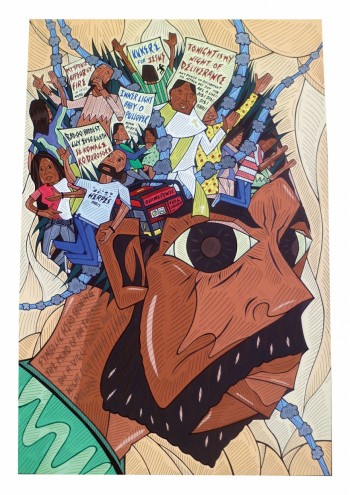From the Series
When Karo Akpokiere received news in January that his work would appear on the Venice Biennale, this Lagos-born draughtsman and artist only had a vague sense of the exhibition’s importance. Months later, standing alongside a wall-hung display of 50 of his new drawings, Akpokiere explained how it was only when the artist list was officially announced for curator Okwui Enwezor’s main exhibition at the 2015 Venice Biennale that he became fully aware of the event’s real significance. His inbox was suddenly flooded with congratulatory emails.
Curious, Akpokiere – a graduate of Yaba College of Technology in Lagos – googled the phrase “Venice Biennale”. His search request yielded a deluge of information about this 120-year-old exhibition, held every other year in the gardens and old military store in Venice.
Akpokiere started to panic. “I studied graphic design and the Venice Biennale was never on my radar,” he says when I meet him in the cavernous Arsenale, one of the two pavilions used to stage Enwezor’s main exhibition, entitled All the World’s Futures. Much though has changed in the past six months.
Aside from Venice, his work also appears on the big showcase exhibition Making Africa at the Vitra Design Museum in southern Germany. When I met Akpokiere for a second time in Venice, he was conducting an interview with an Austrian TV crew. My own interview with him was interrupted by an Israeli curator eager to speak to him about her forthcoming show “about Africa” in Tel Aviv.
“LOL,” Akpokiere later wrote me in an email. “Never been to that part of the world so maybe that might be a likely next location.”
So what’s all the fuss about? It helps to know that Akpokiere is in love with two things: design and Lagos.
Using aspects of graphic design, illustration and pattern design, his work offers a fine-grain encounter with the culture of Lagos, a place of bustling optimism and visible disquiet. This is most evident in his ongoing Mega City Times project, a sprawling and fragmentary graphic narrative about Africa’s most populous metropolitan area. Lagos has 21 million inhabitants.
I feel like there are so many narratives to be gleaned from Lagos, says Akpokiere, who employs both traditional and digital drawing techniques.
“It is a city I want to keep engaging with, to create drawings from.”
His Lagos work is noteworthy for its description of the pervasive and intertwined influence of religion, commerce, travel and hustle on the Lagosian character.
Text-rich and tending towards visual allegory rather than offering plainly descriptive scenes, his noisy and over-populated drawings have a definite zing and distinctive personal character.
“His graphics-based language departs from the usual forms of representing the city, which are mainly through easel painting and documentary photography,” writes US-based Nigerian curator Ugochuwu-Smooth Nzewi in the catalogue accompanying Enwezor’s exhibition. The title of Akpokiere’s Venice work is “Zwischen Lagos und Berlin”. The German title translates as “between Lagos and Berlin” – which pretty much sums up the artist’s year so far (ignoring his detour to Venice).
Akpokiere was a guest artist at the Atelierhaus Mengerzeile, a Berlin artist studio based in a former piano-making factory, when he first caught up with Enwezor. His initial proposal for Venice was an animated piece accompanied by a comic-book publication called Mega City Times.
“It was all meant to be centred around Lagos,” he explains. The idea of a publication was quickly canned: the last Venice Biennale drew 400,000 visitors over its six-month duration and the huge print-run required made his idea unworkable. Things evolved from there.
I was caught up in a lot of movement – back and forth between Lagos and Berlin – when I was creating the new drawings.
“I tried to represent that instability in the drawings, just the constant motion,” says Akpokiere.
His drawings neatly dialogue with another big news story out of Italy at the moment – the flood of migrants from Libya into Europe – by offering a first-person account of the difficulties and strangeness that come with moving between Africa and Europe.
A subtle sense of homesickness pervades his entire series. Elsewhere is strange.
While working on his new work, Akpokiere found himself trying to answer a simple question: “What is the best way to represent Lagos without actually showing it?”
His answer owes a debt to his training in graphics. Many of Akpokiere’s drawings in Venice focus on bits of signage and urban lettering that marked his passage through Berlin and Lagos. “Only E.U. Citizens,” reads one drawing made in Berlin. Another, drawn in Lagos, quotes a prohibition: “No: Hawking, Preaching, Advertising”. Says Akpokiere, “I am more interested in icons and symbols that represent the city.”
It is not just formal or official signage that intrigues Akpokiere. He is fascinated by the graffiti in the yellow busses so much a part of Lagos public life. “I am trying to make contact with the people who do those drawings, to collaborate,” he says.
Maybe we will create a letterset and typography that represents the city through our eyes.
He is also researching the largely undocumented history of pre-colonial and post-independence design in Nigeria. “I would love to know how people in Nigeria, and in Lagos especially, engaged with typography before the British came.”
Akpokiere’s ambitions are not singularly focussed on graphic design. He is currently investigating producing a furniture line. It is not out of character. He has previously collaborated with American online retailer BucketFeet to create the fabric design for a slip-on shoe. His Tokeria shoes feature a geometrical design inspired by the Japanese woodcut aesthetic and African geometric motifs.
Lagos and Berlin, Nigeria and Japan: Akpokiere’s work tells the story of young Nigeria’s fluent and engaging worldliness.
















